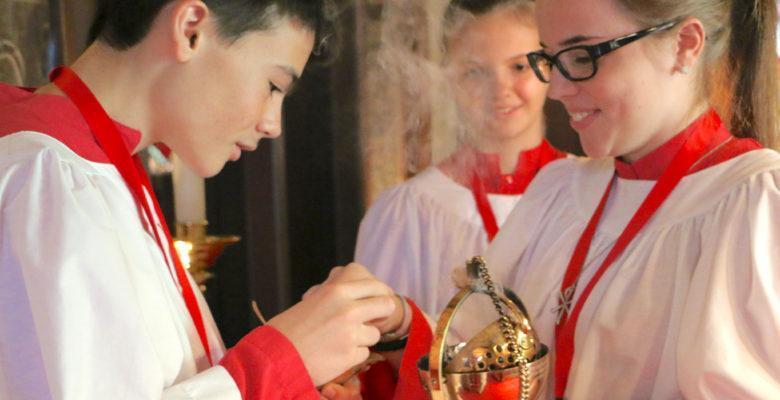“Even young people who said their parents had first ‘forced’ them to acolyte expressed a newfound connection to worship and an enthusiasm for being at church.”
Acolytes = Leaders
Quick! When you think of leadership in the church, what roles do you think of? Priests and deacons? Church staff? Choir directors? Ministry leaders?
Do you ever think about acolytes?
You should, because these young people, whose often un-noticed presence facilitates almost every service, embody true servant leadership. For a sense of why acolyting is an important and formational ministry, I interviewed members of the acolyte corps at my church. Ranging from 4th grade to college senior, here are ten conclusions they shared about their ministry.
10 Hidden Benefits of Acolyting
1. Acolyting is essential
Think of services where no acolytes are present. Much of the beauty and the glorious pageantry is missing. Processions without torches and crosses, and a Gospel reading without anyone to hold the book? Not as impactful. Furthermore, services without acolytes means clergy have less support when preparing Communion, and facilitating worship.
2. Acolyting allows young people to be active participants in worship
Everyone I spoke with echoed the same refrain. They felt much more engaged in the worship service by playing an active role rather than sitting in the pews. Even young people who reported that their parents had at first “forced” them to acolyte, expressed a newfound connection to worship and an enthusiasm for being at church.
3. Acolyting is intergenerational
A young person who acolytes is more likely to feel a connection to adults serving in other worship-related ministries: clergy, altar guild members, greeters, ushers, lectors, lay eucharistic ministers, and choir members.
This is truly important! Young people who connect to generations of adults in the congregation – rather than only forming relationships with youth peers – are more likely to feel a deep connection to their church community. Faith formation is strengthened by these intergenerational relationships.
4. Acolyting is relational
Acolyting helps young people form bonds with their peers, and with older and younger teens at church. Faith is meant to be practiced in community, and when a young person finds community for themselves, they are more likely to grow in faith. Young acolytes spoke proudly of having older teen friends who they knew through acolyting; older teens spoke proudly of acting as role models to the younger teens on their acolyte teams.
5. Acolyting is a family affair
Many young people recalled that they began to acolyte as a way of emulating older siblings. Families are more likely to attend and be connected to a church community when their children serve at the altar.
6. Acolyting allows kids to play with fire
Admit it, everybody likes to play help with fire. But more importantly, when we trust young people with significant and potentially dangerous tasks, we show them that we see them as capable and competent. Inevitably they then live up to our expectations.
7. Acolyting makes a young person the center of attention
This surprised me. Many young people commented on how they enjoyed the feeling of having all eyes on them as they walked down the aisle with the cross. But isn’t it supposed to be about God? Yes. So are we raising a generation of egomaniacs? I don’t think so. Everyone’s deepest desire is to be known, accepted, and loved. We want to have value in the eyes of others. Consider scripture and the many instances where Jesus paused to truly see and engage people who were otherwise invisible in society.
Often our young people feel unseen and unimportant in our faith communities. Acolyting allows them to be seen, to be important, and to make a difference in our communal worship.
8. Acolyting makes young people nervous
When asked what they wished other people knew about being an acolyte, many young people said they wished others knew how seriously they take their role. They try very hard not to make mistakes, and when they do, it weighs heavily on them. Yet in talking about lessons learned as an acolyte, one young person told me the following: “Whatever I do, even if I’m not sure of what I’m doing, as long as I do it with confidence, it will be ok.” Or as Julian of Norwich wrote, “All shall be well.”
9. Acolyting is formational, and teaches liturgy
In conversations replete with teenage slang, I also heard vocabulary that reflected a deep knowledge of liturgy and church tradition. In fact, one of the many reasons youth enjoyed being acolytes is that they learned more about the shape, structure, and flow of liturgy and worship traditions. Young people even mentioned some of their favorite services: Maundy Thursday and Good Friday – services often under-attended, especially by young people.
10. Acolyting is leadership
A component of good church leadership is being able to grow more fully into a ministerial role. The young people I spoke with reflected on their evolving acolyte responsibilities, and how moving from torch to Eucharistic server was “…a big leap.” One young person explained how managing her acolyte team was an opportunity for her to demonstrate maturity and responsibility. Some young people spoke proudly of how acolyting encouraged them to seek out other roles in the church – as vergers, altar guild members, lay eucharistic ministers, and as members of the church’s worship commission.
So Let There Be Acolytes!
Acolyting is an essential ministry, and one that imbues our worship with beauty, solemnity, and pageantry. Acolytes support both clergy and laity, ensuring that the behind-the-scenes tasks and logistics of worship flow smoothly.
Most importantly, our acolytes, whether they are 9 or 19 years old, are leaders in our communities, worthy of appreciation and respect. Next time you see a young person who is an acolyte, make sure to compliment them and thank them for their ministry!
Photo: Acolyte Festival 2012 Diocese of Southwest Florida via Flickr (CC BY 2.0).

